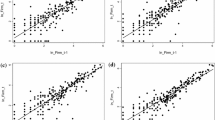Abstract
Improving the economic conditions for small and medium sized firms as well as start-ups is high on the agenda of policy makers. In this paper we discuss some policy options for fostering the creation of new enterprises. The discussion focuses on measures which aim at helping start-ups to overcome liquidity constraints. In order to provide the background for this discussion the paper provides some new empirical results on the determinants of firm foundations as well as some stylised facts on the occurence of liquidity constraints in West-Germany. We analyse the regional distribution of start-up intensity and offer several hypotheses to explain this distribution. To a large extent, the regional distribution of start-ups can be explained by the existing industry structure, regional human capital as well as the regional public traffic infrastructure. Moreover, we show that liquidity constraints occur more often in small and young firms.
Similar content being viewed by others
References
Acs, Zoltan J. and David B. Audretsch, 1990, Small Firms and Entrepreneurship: An East West Perspective, Cambridge: Cambridge University Press.
Acs, Zoltan J. and David B. Audretsch, 1992, ‘Innovationen durch kleine Unternehmen’, Berlin: Edition Sigma.
Albach, Horst, 1987, ‘Geburt und Tod von Unternehmen’, ifm-Materialien 55.
Albach, Horst and Irene Kuron, 1987, ‘Die Gründungsförderung im Handwerk’, ifm-Materialien 51.
Audretsch, David B. and Julie A. Elston, 1994, ‘Does Firm Size Matter? Evidence on the Impact of Liquidity Constraints on Firm Investment Behaviour in Germany’, Centre of Economic Policy Research, CEPR, Discussion Paper 1072.
Becker, Hans Peter, 1982, ‘Gründungsprobleme und die Förderung von Existenzgründungen. Ergebnisse einer Befragung in Baden-Württemberg’, Zeitschrift für betriebswirtschaftliche Forschung 6, 510–523.
Boeri, Tito and Ulrich Cramer, 1991, ‘Betriebliche Wachstumsprozesse: Eine statistische Analyse mit der Beschäftigtenstatistik 1977–1987’, Mitteilungen aus der Arbeitsmarkt-und Berufsforschung 1, 70–80.
Brüderl, Josef, Christoph Bühler and Rolf Ziegler, 1993,’ Beschäftigungswirkung neugegründeter Betriebe’, Mitteilungen aus der Arbeitsmarkt-und Berufsforschung 4, 521–528.
Brujmann, Renate and Ulrich Möller, 1994, ‘Die Industrierezession in Baden-Württemberg und ihre Folgen für den Arbeitsmarkt. Eine Struktur-und Konjunkturanalyse’, Referat für Arbeitsmarkt-und Berufsforschung der Bundesanstalt für Arbeit Stuttgart.
Cramer, Ulrich and Martin Koller, 1988, ‘Gewinne und Verluste von Arbeitsplätzen in Betrieben – der “Job-Turnover”-Ansatz’, Mitteilungen aus der Arbeitsmarkt und Berufsforschung 3, 361–377.
Evans, David S. and Boyan Jovanovic, 1989, ‘An Estimated Model of Entreprneurial Choice under Liquidity Constraints’, Journal of Political Economy 97(4), 808–827.
Evans, David S. and Linda S. Leighton, 1990, ‘Small Business Formation by Unemployed and Employed Workers’, Small Business Economics 2, 319–330
Fazzari, Steven, R. Glen Hubbard and Bruce C. Peterson, 1988, ‘Finance Constraints and Corporate Investment’, Brookings Papers on Economic Activity, 1141–1195.
Felder, Johannes, Dietmar Harhoff, Georg Licht, Eric Nerlinger and Harald Stahl, 1994, ‘Innovationsverhalten der deutschen Wirtschaft. Ergebnisse der Innovationserhebung 1993’, Zentrum für Europäische Wirtschaftsforschung, ZEW Dokumentation 94-01.
Gerke, Wolfgang et al., 1995, ‘Hindernisse und Probleme deutscher mittelständischer Unternehmen und Unternehmensgründer beim Zugang zum deutschen und internationalen Kapitalmarkt im Vergleich zu ausgewählten EU-Ländern’, Baden-Baden: Nomos.
Gerlach, Knut and Joachim Wagner, 1994, ‘Entries, Exits, and the Dynamics of Employment: Lower Saxony, 1978– 1990’, in Johannes Schwarze et. al. (eds.), Labour Market Dynamics in Present Day Germany, Frankfurt/Main: Campus, pp. 240–259.
Hamermesh, Daniel S., 1993, Labor Demand, Princeton: Princeton University Press.
Harhoff, Dietmar and Georg Licht, 1993, ‘Das Mannheimer Innovationspanel’, in Joachim Wagner and Uwe Hochmuth (eds.), Firmenpanelstudien in Deutschland, Tübingen: Francke, pp. 255–284.
Harhoff, Dietmar and Georg Licht (eds.), 1996, ‘Die Innovationsaktivitäten kleiner und mittlerer Unternehmen. Ergebnisse des Mannheimer Innovationspanels’, Zentrum für Europäische Wirtschaftsforschung, Schriftreihe des ZEW 8, Baden-Baden: Nomos.
Harhoff, Dietmar, 1996, ‘Financing Constraints for R&D and Investment in German Manufactoring Firms 1987–1994’, Mannheim: Mimeo.
Himmelberg, Charles P. and Bruce C. Petersen, 1994, ‘R&D and Internal Finance: A Panel Study of Small Firms in High-Tech Industries’, Review of Economics and Statistics 76, 38–51.
Jaffe, D. M. and Joseph E. Stiglitz, 1990, ‘Credit Rationing’, in Benjamin M. Friedmann and Frank H. Hahn (eds.), Handbook of Monetary Economics II, Amsterdam: Elsevier Science Publishers, pp. 837–888.
König, Heinz, Herbert Buscher and Georg Licht, 1995,’ Investment, Employment and Innovation’, in OECD (eds.), The OECD Jobs Study. Investment, Productivity and Employment, Paris: OECD, pp. 67–81.
Nerlinger, Eric and Georg Berger, 1995, ‘Regionale Verteilung technologieorientierter Unternehmen’, Zentrum für Europäische Wirtschaftsforschung, ZEW-Discussion Paper 21-95.
OECD, 1992, ‘OECD Proposed Guidelines For Collecting and Interpreting Technological Innovation Data – OSLO Manual’, Paris: OECD.
Pfeiffer, Friedhelm and Winfried Pohlmeier, 1992, ‘Income Uncertainty and the Probability of Self-Employment’, Recherches Economiques de Louvain 58(3–4), 265–281.
Pfeiffer, Friedhelm, 1994, ‘Selbständige und abhängige Erwerbstätigkeit’, Frankfurt/Main: Campus.
Schmude, Jürgen, 1994, ‘Geförderte Unternehmensgründungen in Baden-Württemberg’, Stuttgart: Franz Steiner.
Schulz, Norbert, 1995, ‘Unternehmensgründungen und Markteintritt’, Heidelberg: Physica.
Smith, Keith, 1992, ‘Technological Innovation Indicators: Experience and Prospects’, Science and Public Policy 6, 383–392.
Stiglitz, Joseph E. and Andrew Weiss, 1981, ‘Credit Rationing in Markets with Imperfect Information’, American Economic Review 71, 393–410.
Storey, David J., 1982, Entrepreneurship and the New Firm, London: Crom Helm.
Wagner, Joachim, 1994, ‘The Post-Entry Performance of New Small Firms in German Manufacturing Industries’, Journal of Industrial Economics 2, June, 141–154.
Author information
Authors and Affiliations
Rights and permissions
About this article
Cite this article
Egeln, J., Licht, G. & Steil, F. Firm Foundations and the Role of Financing Constraints. Small Business Economics 9, 137–150 (1997). https://doi.org/10.1023/A:1007919806417
Issue Date:
DOI: https://doi.org/10.1023/A:1007919806417




